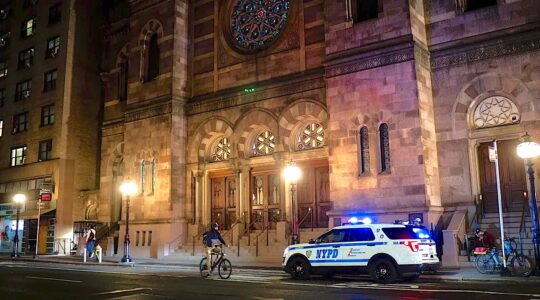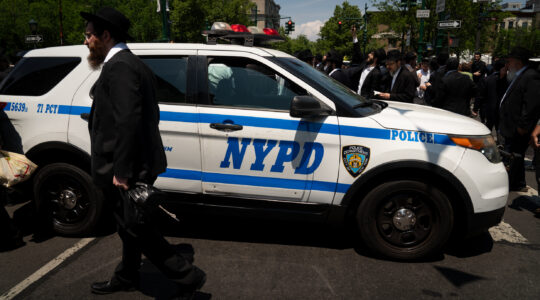There is no shortage of synagogues in Brooklyn. Many are beautiful and some are unusual, but most are unknown except to their congregants. In order to help protect this heritage of often aging religious buildings, the New York Landmarks Conservancy embarked in 2006 on a project to survey them.
As a result, several synagogues have been nominated to the National Register of Historic Places, and among these is one special for its place in modern art: the Kingsway Jewish Center, an Orthodox synagogue in the borough’s Flatbush section. Built from 1951 to 1957, the sanctuary was decorated with a suite of stained glass windows designed by Adolph Gottlieb. These little-known windows are precious examples of the position of New York’s abstract art outside the world of galleries and museums. They also provide positive evidence of a Jewish component in Gottlieb’s work. The windows are in poor condition, but the Kingsway congregation and the Adolph and Esther Gottlieb Foundation anticipate that National Register designation would help spur fundraising for their conservation. Ann Friedman, director of the Sacred Sites Program of the New York Landmarks Conservancy, says that it was when viewing Kingsway in 2004 that she realized “the great but under-recognized synagogue architecture in New York.”
Gottlieb was a leading member of the Abstract Expressionist movement, recognized by artists, critics and proponents of the movement as one of its intellectual and creative forces. As early as 1943, Gottlieb and close friend Mark Rothko described their credo of abstract art in a letter to The New York Times: “We want to reassert the picture plane. We are for flat forms, because they destroy illusion and reveal truth.”
Like most of his peers who began to paint in the years between the World Wars, Gottlieb began with representation, but quickly moved to abstraction, influenced by European movements. He developed a distinctive style beginning in 1941, when he began arranging groups of pictographs in rows that suggest a language but, ultimately, invite the viewer to arrive at a personal interpretation and understanding.
Before the Kingsway commission, Gottlieb was already a pioneer in creating modern synagogue art. In 1951, at the invitation of architect Percival Goodman, he designed a Torah ark curtain (now in The Jewish Museum) for Congregation B’nai Israel in Milburn, N.J. He worked again with Goodman for Congregation Beth El in Springfield, Mass., subsequently destroyed in a fire in 1965. In 1952, Gottlieb received a commission to design a five-story 1,300-square-foot facade of stained glass for an extension to Manhattan’s Park Avenue Synagogue. That project, completed in 1955, was dismantled in 1980, but it led directly to the Kingsway windows.
According to Sanford Hirsch, director of the Gottlieb Foundation, Gottlieb’s synagogue commissions, which were inspired by concrete Jewish symbols and themes, are fundamentally different from the rest of his oeuvre, in which he strove to create a visual language without specific literal meaning.
“Gottlieb claimed, after the fact, that he simply argued that the images symbolized different Jewish themes or holidays so that he could have his challenging work accepted by conservative congregations,” Hirsch said. “There is some truth to that, but the images in the stained glass works do, in fact, relate to specific themes, which he researched in order to develop.”
Architectural historian Tony Robins has shown that Gottlieb’s involvement with Kingsway began in April 1955, when he was contacted by the synagogue’s vice president, Robert Judd, who had seen the Park Avenue windows and wanted Gottlieb’s work in Brooklyn. The synagogue sanctuary was already built, and Gottlieb was engaged to create windows to fill the already defined spaces. To reduce costs Gottlieb designed the windows to use a minimum of colored glass. Gottlieb was asked to illustrate 10 holidays: Rosh HaShanah, Yom Kippur, Sukkot, Simchat Torah, Chanukah, Tu b’Shvat, Purim, Passover, Shavuot and Tisha b’Av. Simchat Torah was later replaced by the Sabbath.
Gottlieb conceived his design to reflect the architecture of the sanctuary, where there is banked seating parallel to the long walls facing an open space in which the bima occupies a central spot. This is an adaptation of the traditional Sephardic plan, one that very few Ashkenazi synagogues have ever used. For Gottlieb, it provided a seating arrangement where congregants would always be facing the side windows, which thus gain importance.
Gottlieb created a pattern in which the five windows on the north and south walls contain the designs that relate to the 10 holidays. For the four high windows on the east (ark) and west (entrance) walls, Gottlieb created a motif incorporating the Star of David and a symbol for light, arranged asymmetrically, to create a rhythmic pattern. Through the whole window program there is an overall pattern, where the facing walls reflect each other. Each of the side windows has the same shape, size and overall arrangement, but the changes in the shape and color of the smaller glass panes, and the specific design and images create a rhythm that pulses with each day’s shifting light.
The congregation was certainly ahead of the curve in commissioning such an untraditional artist as Gottlieb. Whatever doubts the Brooklyn congregation might have had were probably assuaged somewhat in 1957 when The Jewish Museum mounted a Gottlieb one-man exhibition — the first for a living Abstract Expressionist in a major New York museum.
Now, a half century later, it’s time again to look at Gottlieb and restore his windows and his place in the history of synagogue art.
Support the New York Jewish Week
Our nonprofit newsroom depends on readers like you. Make a donation now to support independent Jewish journalism in New York.
Samuel D. Gruber is director of the Jewish Heritage Research Center in Syracuse, N.Y. His books include “American Synagogues: A Century of Architecture and Jewish Community” (Rizzoli, 2003). Reprinted from Tabletmag.com
The New York Jewish Week brings you the stories behind the headlines, keeping you connected to Jewish life in New York. Help sustain the reporting you trust by donating today.




